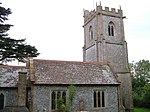Knowle St Giles
Civil parishes in SomersetVillages in South Somerset

Knowle St Giles is a village and civil parish in the South Somerset district of Somerset, England, situated on the River Isle 2 miles (3 km) south of Ilminster and 2.5 miles (4 km) north east of Chard. The village has a population of 244.The parish includes the village of Cricket Malherbie.
Excerpt from the Wikipedia article Knowle St Giles (License: CC BY-SA 3.0, Authors, Images).Knowle St Giles
Wooley Lane,
Geographical coordinates (GPS) Address Nearby Places Show on map
Geographical coordinates (GPS)
| Latitude | Longitude |
|---|---|
| N 50.899246 ° | E -2.932789 ° |
Address
Wooley Lane
Wooley Lane
TA20 4AZ , Knowle St. Giles
England, United Kingdom
Open on Google Maps









